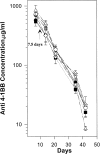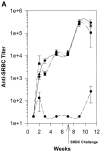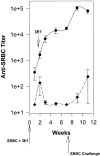Anti-4-1BB monoclonal antibodies abrogate T cell-dependent humoral immune responses in vivo through the induction of helper T cell anergy
- PMID: 10562327
- PMCID: PMC2195697
- DOI: 10.1084/jem.190.10.1535
Anti-4-1BB monoclonal antibodies abrogate T cell-dependent humoral immune responses in vivo through the induction of helper T cell anergy
Abstract
The 4-1BB receptor (CDw137), a member of the tumor necrosis factor receptor superfamily, has been shown to costimulate the activation of T cells. Here we show that anti-mouse 4-1BB monoclonal antibodies (mAbs) inhibit thymus-dependent antibody production by B cells. Injection of anti-4-1BB mAbs into mice being immunized with cellular or soluble protein antigens induced long-term anergy of antigen-specific T cells. The immune response to the type II T cell-independent antigen trinintrophenol-conjugated Ficoll, however, was not suppressed. Inhibition of humoral immunity occurred only when anti-4-1BB mAb was given within 1 wk after immunization. Anti-4-1BB inhibition was observed in mice lacking functional CD8(+) T cells, indicating that CD8(+) T cells were not required for the induction of anergy. Analysis of the requirements for the anti-4-1BB-mediated inhibition of humoral immunity revealed that suppression could not be adoptively transferred with T cells from anti-4-1BB-treated mice. Transfer of BALB/c splenic T cells from sheep red blood cell (SRBC)-immunized and anti-4-1BB-treated mice together with normal BALB/c B cells into C.B-17 severe combined immunodeficient mice failed to generate an anti-SRBC response. However, B cells from the SRBC-immunized, anti-4-1BB-treated BALB/c mice, together with normal naive T cells, exhibited a normal humoral immune response against SRBC after transfer, demonstrating that SRBC-specific B cells were left unaffected by anti-4-1BB mAbs.
Figures






References
-
- Pollok K.E., Kim Y.-J., Zhou Z., Hurtado J., Kim K.K., Pickard R.T., Kwon B.S. Inducible T cell antigen 4-1BB. Analysis of expression and function. J. Immunol. 1993;150:771–781. - PubMed
-
- Mellero I., Johnston J.V., Shufford W.W., Mittler R.S., Chen L. NK1.1 cells express 4-1BB (CDw137) costimulatory molecule and are required for tumor immunity elicited by anti-4-1BB monoclonal antibodies. Cell. Immunol. 1998;190:167–172. - PubMed
-
- Hurtado J.C., Kim S.H., Pollack K.E., Lee Z.H., Kwon B.S. Potential role of 4-1BB in T cell activation. Comparison with the costimulatory molecule CD28. J. Immunol. 1995;155:3360–3367. - PubMed
-
- Hurtado J., Kim Y.-J., Kwon B.S. Signals through 4-1BB are costimulatory to previously activated splenic T cells and inhibit activation-induced cell death. J. Immunol. 1997;158:2600–2609. - PubMed
MeSH terms
Substances
LinkOut - more resources
Full Text Sources
Other Literature Sources
Research Materials

